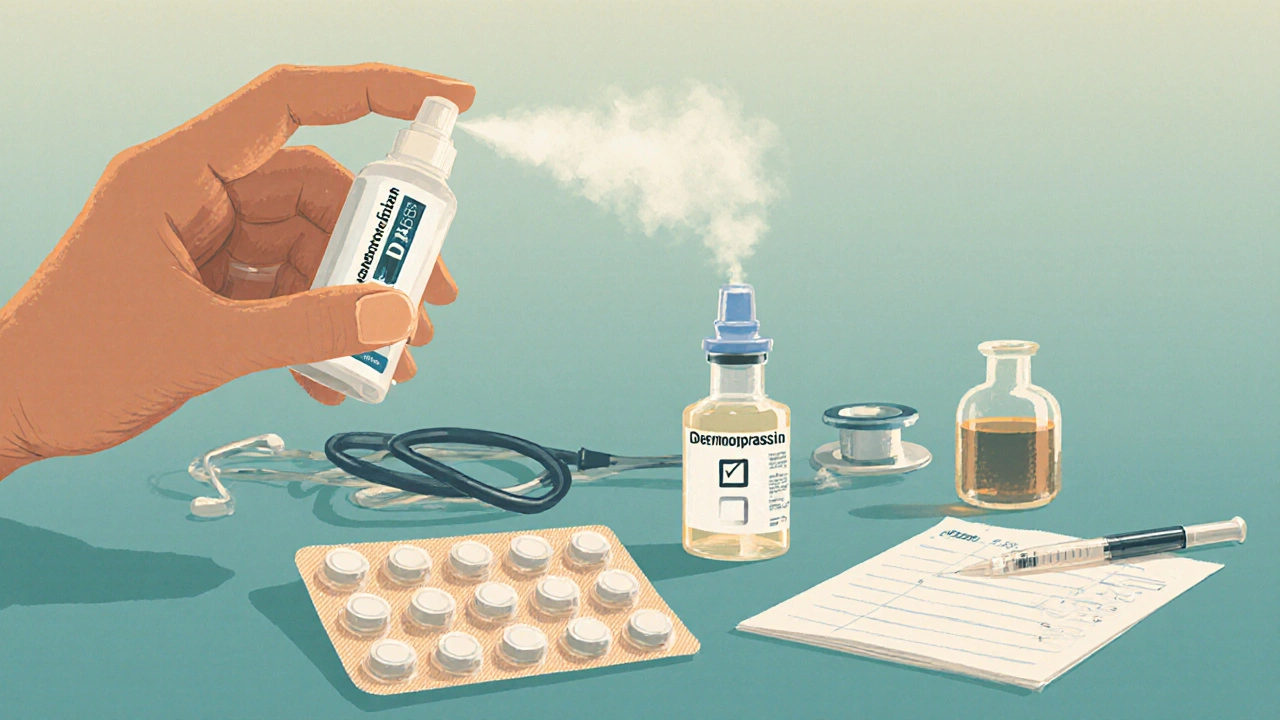Central DI Dosage Calculator
Enter values and click calculate to see recommended dosage.
Quick Summary
- Central cranial diabetes insipidus (DI) is caused by a lack of antidiuretic hormone (ADH) from the brain.
- Hormone replacement therapy (HRT) restores the missing hormone, most often using desmopressin.
- Correct dosing, regular monitoring of urine output and serum sodium, and patient education are critical for safety.
- Side‑effects include water retention, low sodium, and rare allergic reactions.
- HRT works best for most patients, but alternatives exist for those with intolerance or special circumstances.
Patients with central cranial diabetes insipidus (DI) constantly battle excessive thirst and frequent urination. The missing piece is usually a hormone called antidiuretic hormone, also known as vasopressin. Hormone Replacement Therapy is a medical approach that supplies the body with hormones it cannot produce on its own. In the case of central DI, HRT aims to replace the absent ADH and bring the body’s water balance back to normal.
Understanding Central Cranial Diabetes Insipidus
Central Cranial Diabetes Insipidus is a rare disorder where the hypothalamus or pituitary gland fails to produce enough antidiuretic hormone (ADH). Without ADH, the kidneys cannot re‑absorb water, leading to large volumes of dilute urine (polyuria) and intense thirst (polydipsia). The condition can follow head trauma, brain surgery, tumors, or autoimmune inflammation.
The hallmark signs are:
- Urine output exceeding 3L per day (often 6-10L).
- Serum sodium that drifts toward the high‑normal range or above.
- Persistent dry mouth and the urge to drink water constantly.
Diagnosis typically involves a water‑deprivation test, measurement of plasma ADH levels, and MRI imaging to assess the hypothalamic‑pituitary area.
How Hormone Replacement Therapy Works in DI
The goal of HRT is simple: give the body a synthetic version of ADH that the brain can’t make. Antidiuretic Hormone acts on the kidney’s collecting ducts to promote water re‑absorption. When a patient takes a replacement, the kidneys start concentrating urine again, reducing volume and stabilizing blood‑sodium levels.
Unlike a “cure,” HRT is a lifelong management tool. The therapy must mimic the natural rhythm of ADH release: low during the day, slightly higher at night. Modern analogues are designed for longer half‑lives, allowing once‑daily or twice‑daily dosing.

Common Hormone Replacement Options for Central DI
The most widely used agent is Desmopressin a synthetic vasopressin analogue with high selectivity for V2 receptors in the kidney. Desmopressin comes in three forms:
- Intranasal spray (typically 10-40µg per dose).
- Oral tablets or melt‑away tablets (0.1-0.4mg).
- Injectable solution for acute settings or when oral/nasal routes are not feasible.
Other synthetic vasopressin analogues, such as Lypressin a peptide hormone similar to natural ADH but less commonly used, are available in some countries but lack the extensive safety data of desmopressin.
Dosing and Administration Guidelines
Starting doses depend on age, weight, and severity of polyuria. A typical titration schedule looks like this:
- Day1‑3: Begin with a low dose (e.g., 10µg intranasal or 0.1mg oral) taken once in the morning.
- Day4‑7: Assess urine volume after 24h. If output >2L, increase the dose by 5‑10µg (nasal) or 0.05mg (oral).
- Week2‑4: Aim for a target urine volume of 1‑2L per day and stable serum sodium (135‑145mmol/L). Adjust in small increments until goals are met.
- Maintenance: Most adults settle on 20‑30µg nasal or 0.15‑0.3mg oral daily, split into morning and evening doses.
Key administration tips:
- Take the dose at the same times each day to mimic natural ADH peaks.
- Do not crush intranasal spray; administer directly into each nostril.
- If a dose is missed, take it as soon as remembered unless it’s within 4hours of the next scheduled dose-skip the missed one to avoid overdose.
Monitoring Treatment Success
Effective monitoring prevents complications and ensures the dose remains appropriate.
- Urine output: Measure 24‑hour volume. A drop to 1‑2L indicates adequate control.
- Serum sodium: Check every 1‑2 weeks during titration, then every 3‑6 months once stable.
- Weight and fluid balance: Sudden weight gain may signal water retention.
- Symptoms: Ask about headaches, nausea, or excessive fatigue-these can hint at hyponatremia.
Patients should be educated to recognize early signs of low sodium, such as mild confusion or lethargy, and to seek medical help immediately.
Benefits and Risks of Hormone Replacement Therapy
**Benefits**
- Restores normal daily urine volume, improving quality of life.
- Reduces constant thirst, allowing normal sleep patterns.
- Stabilizes serum sodium, decreasing risk of hypernatremia‑related complications.
**Potential Risks**
- Hyponatremia occurs when excess water dilutes blood sodium, potentially causing seizures. It is most common with over‑dosing or in patients who continue to drink large volumes.
- Allergic reactions to nasal spray components (rare).
- Headache or nasal irritation for intranasal users.
To minimise risk, keep fluid intake proportional to the dose, especially during the first weeks of therapy.

When Hormone Replacement May Not Be Suitable
Although HRT works for the majority, certain scenarios call for alternative strategies:
- Severe renal impairment: kidneys cannot respond to ADH, so replacement offers little benefit.
- Uncontrolled hyponatremia from other causes (e.g., heart failure) - adding ADH analogues can worsen the imbalance.
- Pregnancy: desmopressin is generally considered safe, but dosing may need adjustment under obstetric supervision.
In such cases, doctors may turn to low‑dose thiazide diuretics or a regulated water‑intake plan to control urine output.
Comparison of Hormone Replacement Therapy vs. Alternative Approaches
| Option | Mechanism | Typical Dose Form | Pros | Cons |
|---|---|---|---|---|
| Desmopressin (HRT) | V2‑receptor agonist → kidney water re‑absorption | Intranasal, oral, injectable | Effective, quick titration, well‑studied | Risk of hyponatremia, requires monitoring |
| Thiazide Diuretic | Induces mild hypovolemia → enhances proximal water re‑absorption | Oral tablet | Useful when HRT contraindicated, inexpensive | May cause low potassium, not as precise |
| Low‑Sodium Diet + Fluid Regulation | Reduces osmotic load, limits urine volume | Behavioral | No medication side‑effects | Hard to maintain, less effective alone |
| Vasopressin Injection (rare) | Direct ADH replacement | IV/IM injection | Rapid effect in emergencies | Short‑acting, requires medical setting |
For most adults, desmopressin remains the first‑line choice because its targeted action produces the most reliable control of urine output with manageable side‑effects.
Practical Tips for Patients and Caregivers
- Keep a daily log of fluid intake, urine volume, and any symptoms.
- Carry a medical alert card stating you are on desmopressin and your target serum sodium.
- Never double‑dose if you forget a dose; instead, follow the “skip if within 4hours” rule.
- Inform any new healthcare provider about your HRT regimen before surgeries or diagnostic tests.
- Check the expiration date of nasal spray; potency declines after opening.
Frequently Asked Questions
Can I stop desmopressin once my DI is under control?
No. Central DI is a permanent deficiency of ADH. Stopping the medication will cause urine output to surge again and can lead to dangerous dehydration.
Is desmopressin safe for children?
Yes, pediatric doses are lower (often 5‑10µg nasal or 0.05‑0.1mg oral) and are adjusted based on weight and urine output. Close monitoring is essential.
What should I do if I develop mild hyponatremia?
First, reduce fluid intake slightly and hold the next dose until you speak with your doctor. Blood tests will confirm the sodium level and guide dosage adjustment.
Are there any drug interactions with desmoxepin?
Desmopressin can amplify the effect of other antidiuretic agents, such as certain chemotherapy drugs (e.g., cyclophosphamide) or NSAIDs, increasing hyponatremia risk. Always list all medications to your endocrinologist.
Can I travel with my nasal spray?
Yes, but keep it in original packaging, carry a copy of your prescription, and check airline regulations for liquid medication. Store it at room temperature and avoid extreme heat.
Hormone replacement therapy, especially desmopressin, has transformed the lives of people living with central cranial diabetes insipidus. By understanding how the therapy works, following dosing guidelines, and staying vigilant about monitoring, patients can enjoy normal fluid balance and a much better quality of life.





One comment
When we contemplate the intricacies of central diabetes insipidus, we must first acknowledge the elegant choreography of vasopressin pathways that have been deranged by a loss of hypothalamic production. The absence of antidiuretic hormone precipitates an inexorable cascade of polyuria, nocturia, and profound dehydration, each symptom acting as a stark reminder of the body's reliance on homeostatic precision. Hormone replacement therapy, therefore, is not merely a symptomatic palliative; it is an attempt to restore a missing piece of an ancient physiological symphony. Desmopressin, the synthetic analogue, mimics the vasopressin V2 receptor activation, coaxing renal collecting ducts to reabsorb water, thereby reducing urine output to manageable levels. However, the therapeutic journey is fraught with nuance: dosage must be titrated to the individual's weight, renal function, and circadian rhythm, lest we precipitate hyponatremia, a perilous drop in serum sodium that can culminate in cerebral edema. Moreover, the route of administration-intranasal spray versus oral tablet-introduces variables of bioavailability and patient adherence, each demanding careful consideration. It is imperative to monitor plasma sodium concentrations regularly, especially in the initial titration phase, to safeguard against insidious electrolyte disturbances. The calculator presented in the original post serves as a valuable heuristic, yet clinicians must appreciate that it rests upon population averages and cannot substitute for personalized clinical judgment. In patients with concomitant pituitary insufficiencies, the interplay of other hormonal axes-cortisol, thyroid, gonadal-must be evaluated to ensure that the replacement of vasopressin does not unmask deficiencies elsewhere. Additionally, psychosocial factors such as the patient's lifestyle, occupational demands, and access to healthcare resources influence the choice between a nasal spray that can be discreetly administered and an oral tablet that may be more convenient but less precise. As the therapeutic paradigm evolves, emerging formulations with extended-release properties promise to smooth out the peaks and troughs of plasma desmopressin levels, potentially reducing the burden of frequent dosing. Yet, the timeless principle remains: hormone replacement in central DI is a dance between science and art, requiring a vigilant eye, a compassionate ear, and a willingness to adjust the steps as the patient's condition waxes and wanes.
Alright, let’s cut through the jargon and get to the heart of the matter-central DI isn’t just some obscure footnote in endocrinology, it’s a daily juggling act for those who live with it. The neat thing about the desmopressin calculator is that it tries to demystify dosing, but remember, real‑world bodies love to insult spreadsheets. If you’re a fan of color‑coded charts, great, but keep your eyes on the lab values-especially sodium-because the line between therapeutic and toxic can be razor‑thin. And hey, don’t forget the lifestyle angle: Night‑shifts, marathon training, or a toddler on the go can all tip the balance. Bottom line? Use the tool, but let your clinician tailor the script to your unique rhythm.
Hey folks! Just wanted to add a friendly reminder that while the dosage calculator is super handy, it’s still a good idea to have regular check‑ins with your endocrinologist. They’ll keep an eye on your blood pressure, sodium levels, and make sure you’re not getting too thirsty or too little. Stay hydrated (but not over‑hydrated) and keep a log of your urine output if you can-it really helps fine‑tune the treatment.
Great tool! 😎 Just a heads‑up: the intranasal spray can be a bit messy if you’re not careful, so make sure to prime the device and avoid blowing your nose right after dosing. Also, keep an eye on those emojis-you’ll want a 👍 on your labs, not a 😬.
Quick tip: start low, go slow. Adjust every few days based on output.
Ah, the ever‑illustrious calculator-behold!; a marvel of modern medicine; yet, let us not be beguiled by its gleaming interface, for the human body, in all its glorious complexity, oft‑defies the neatness of algorithms!!! Remember: hyponatremia is a silent siren; vigilance is paramount!!!
From a cultural lens, it’s fascinating how different societies approach DI-some rely on oral tablets, others favor nasal sprays, and a few even explore traditional herbal adjuncts. Whatever your preference, the key is consistency; your kidneys don’t care about geography, they only care about the hormone signal you give them.
Honestly, discovering that there’s a calculator to help figure out my desmopressin dose was like finding a beacon in a fog of medical bewilderment. I’ve always been a bit of a pessimist when it comes to chronic illnesses, but this tool gave me a tangible sense of control-like I finally have a map for navigating the endless desert of polyuria. It’s not just numbers; it’s empowerment, a reminder that I’m not floating helplessly in a sea of uncertainty. So, to anyone feeling overwhelmed: take a breath, punch in your weight, volume, and route, and watch as the numbers align like a sunrise breaking through clouds. Trust the process, stay diligent with labs, and remember that every small adjustment is a victory.